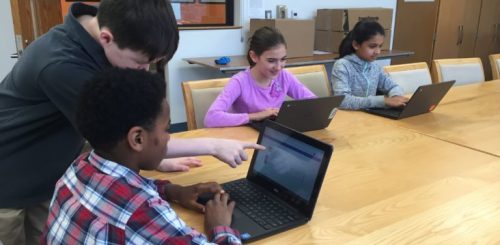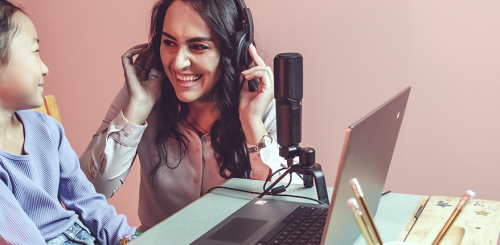
4 Benefits & Ideas for Classroom Podcasting
September 22, 2017“In humans, as in songbirds, the sounds produced by the individuals are essential for normal vocal development.” – Nature Reviews Neuroscience, 2000
Classroom Podcasting …the not-so-latest buzzword going around in education circles. This is an exciting medium for adding to our teaching toolkit but, as educators, we of course benefit from taking a thoughtful approach. There are many rich reasons why we should integrate audio recording, including podcasts, into the classroom. My suggestion? Get some great implementation ideas from your peers and then, by all means, JUMP!
4 Student Benefits to Understand
When you understand some of the powerful ways audio recording in the classroom can benefit student learning, it will be easy to make a strong case to your administrators, your peers, and, not least of all, to yourself! There are numerous tools that make podcasting and media-making simple for teacher and student alike, but using technology without understanding the specific student needs in play, and why it effectively addresses them, isn’t strategic. Here are some of the important student benefits that are helpful for each of us to understand, to look out for when evaluating our use of recorded audio in the classroom, and to be able to explain to others:
- Clarification and Confidence – As your learners listen closely to their tone, learn to include appropriate pauses, and master their speaking through repetition, they will clarify their personal voice and become more confident speakers.
- Reflection and Discussion – Working with recorded audio offers students an alternative place and space to reflect on their thinking and engage in candid discussions about their work. These discussions lead students toward the opportunity to construct new and improved ideas.
- Read, Revise, Practice, and Present – When your learners record themselves reading their writing, it gives them a new perspective on the written word and an alternative method for revision. Further, as students read and revise their writing, they are engaging in much-needed practice before making the oral presentation to peers. The combination of writing and presenting is authentic practice for what students will have to master when they enter higher education and the workforce.
- Assessment Minus Anxiety – If the task at hand is to assess our learners’ understanding, rather than their writing, we can now lower their blood pressure by giving them an alternative space to explain themselves that doesn’t include worrying about spelling errors or sentence structure.
6 Phases of Incorporating Audio Recording
A while back I came across integration coach Corey Holmer’s presentation “Broadcasting Your Story: Podcasting with Chromebooks” and was immediately a) inspired, b) grateful for the work he had already done, and c) excited to share with my teaching peers. He very simply breaks down the podcasting process into six phases for teachers who are interested in incorporating audio recording in the classroom:
- Goal Determination
- Scripting
- Software Acclimation
- Planning & Implementing Recording
- Editing
- Publishing
In addition to explaining each of the steps in detail, Holmer also provided his audience a Podcasting Project Guide. Although this was originally created for a workshop session of educators, it can be easily adapted for any classroom. Even if you have little or no personal experience with podcast creation in the classroom, no problem – I find Mr. Holmer’s explanation easy to understand and a fantastic place to start!
4 Ideas (And Many More) to Try Now!
Need more inspiration on audio recording ideas? Check out the classroom projects, lesson plans and ideas I have compiled here from various educators across the globe. Here are just some of my favorites:
- Use podcasts in conjunction with Google Tour Builder to create virtual field trips with student recorded tour guide voice overs.
- Build an original soundtrack that compliments the rising action, climax, and resolution of a novel.
- Create a “day in the life” documentary that describes the sights, sounds and activities in an ancient metropolis.
- On a field trip, students use a voice recorder, such as the one available through the Soundtrap app, to take notes and a digital camera to take photos.
 EDU Portal
EDU Portal


